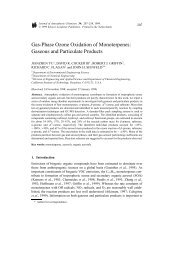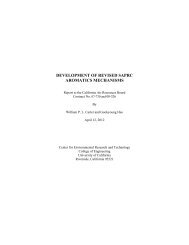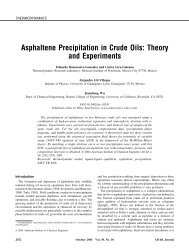Density functional theory for chemical engineering: From capillarity ...
Density functional theory for chemical engineering: From capillarity ...
Density functional theory for chemical engineering: From capillarity ...
Create successful ePaper yourself
Turn your PDF publications into a flip-book with our unique Google optimized e-Paper software.
from the van der Waals equation of state. A first step toward an<br />
improvement is by a quadratic density expansion of the excess<br />
Helmholtz energy <strong>functional</strong> relative to that <strong>for</strong> a uni<strong>for</strong>m<br />
fluid: 54<br />
F ex att F ex att 0 i i<br />
att dr ir<br />
i<br />
k BT<br />
2<br />
<br />
i, j<br />
<br />
drdrc att ij r r i r j r (12)<br />
where F ex att ( 0 i ) is the attractive part of the excess Helmholtz<br />
energy of the reference bulk fluid and 0 i is the average density<br />
of an atomic component i. This “semiquadratic” approach<br />
requires the excess <strong>chemical</strong> potential ex att and the direct correlation<br />
function c att ij (r) of a uni<strong>for</strong>m atomic fluid as input. For<br />
that purpose, the analytical correlation functions derived from<br />
the first-order mean-spherical approximation (FMSA) are particularly<br />
useful. 55-60 It has been demonstrated that, at least <strong>for</strong><br />
relatively simple models such as Lennard–Jones systems and<br />
coarse-grained models of polymers, excellent agreement between<br />
<strong>theory</strong> and simulation results can be attained. 61 Because<br />
the analytical expressions of both the excess <strong>chemical</strong> potentials<br />
and direct correlation functions are readily available from<br />
FMSA, the numerical implementation and computational cost<br />
of the quadratic approximation are very comparable to those<br />
<strong>for</strong> a mean-field approach.<br />
Weak Association. Another important component in a conventional<br />
<strong>for</strong>ce field is the <strong>for</strong>mation of <strong>chemical</strong> or hydrogen<br />
bonds as in associating fluids. For fluid-phase equilibrium<br />
calculations, the thermodynamic perturbation <strong>theory</strong> 62,63 has<br />
been successfully used to develop the statistical associating<br />
fluid <strong>theory</strong> (SAFT), a generic equation of state <strong>for</strong> associating<br />
fluids and also <strong>for</strong> polymers. 64 By incorporation of basic concepts<br />
from DFT, various extensions of SAFT have been applied<br />
to inhomogeneous associating fluids near a hard wall, in<br />
slit pores, and at vapor–liquid or liquid–liquid interfaces. 65-73 A<br />
relatively simple version of the excess Helmholtz energy <strong>functional</strong><br />
was recently derived by introducing the scalar- and<br />
vector-weighted densities of FMT into the SAFT equation of<br />
state:<br />
F ex<br />
ass k B T drn <br />
0 i ln X A <br />
i X A i /2 1/2 (13)<br />
i, A<br />
where the subscript i stands <strong>for</strong> the atomic species i with the<br />
association site A. The inhomogeneous factor i is related to<br />
Rosenfeld’s weighted densities by<br />
2<br />
i 1 n V2,i n V2,i /n 2,i<br />
(14)<br />
(<br />
and X A) i is the local fraction of i not bonded at an associating<br />
site A. It has been demonstrated that Eqs. 13 and 14 provide a<br />
quantitative description of <strong>chemical</strong> bonding <strong>for</strong> inhomogeneous<br />
associating fluids including waterlike molecules. 68<br />
Electrostatics. For systems with Coulomb interactions, a<br />
common DFT approach uses a quadratic density expansion of<br />
the Helmholtz energy <strong>functional</strong> with respect to that of a bulk<br />
fluid or a suitably chosen, position-dependent reference fluid.<br />
74-78 Similar to Eq. 12, the direct correlation functions in this<br />
“semiquadratic” expansion are obtained from an integral-equation<br />
<strong>theory</strong>, mostly from the analytical solutions of the meanspherical<br />
approximation (MSA). 79 Unlike various mean-field<br />
theories derived from the Poisson–Boltzmann (PB) equation,<br />
the quadratic approximation is often sufficient to capture a<br />
number of counterintuitive electrostatic phenomena observed<br />
in solutions containing multivalent ions such as charge inversion<br />
of macroions and attraction between like charges. 80,81 The<br />
limitation of the PB equation arises from its neglect of the size<br />
of small ions and the correlation of charge distributions.<br />
Correlations Attributed to Chain Connectivity. Application<br />
of classical DFT to polymeric systems was first discussed<br />
by Chandler, McCoy, and Singer (CMS) in 1986. 82 The past<br />
few years have witnessed enormous growth in this area. 83-88<br />
Early versions of polymer DFT were heavily influenced by the<br />
self-consistent field <strong>theory</strong> and by Landau expansions <strong>for</strong> the<br />
selection of the reference system or <strong>for</strong> the <strong>for</strong>mulation of the<br />
free-energy <strong>functional</strong>. These influences remain evident in different<br />
versions of dynamic DFT. 14,30 Most recent applications<br />
of DFT, however, adopt segment-level intermolecular <strong>for</strong>ces<br />
following either the CMS <strong>theory</strong> or the generalized thermodynamic<br />
perturbation <strong>theory</strong>. 89 The <strong>for</strong>mer is based on a quadratic<br />
density expansion of the Helmholtz energy <strong>functional</strong> with<br />
respect to that <strong>for</strong> a system of ideal chains, much like the<br />
methods used <strong>for</strong> simple or charged fluids. 90-92 This approach<br />
requires as input the direct correlation functions from the<br />
polymer integral-equation <strong>theory</strong> (that is, PRISM 93 ) and the<br />
intramolecular correlation functions from a single-chain Monte<br />
Carlo simulation. Similar to the hypernetted-chain approximation<br />
<strong>for</strong> simple fluids, CMS <strong>theory</strong> is unable to describe phase<br />
transitions such as liquid–vapor coexistence. The generalized<br />
thermodynamic perturbation <strong>theory</strong> was initially introduced by<br />
Kierlik and Rosinburg, 89 who built on earlier work by Woodward.<br />
94,95 In this approach, the Helmholtz energy <strong>functional</strong><br />
includes an exact <strong>for</strong>malism <strong>for</strong> the ideal chains that retains the<br />
details of bond connectivity and an excess part accounting <strong>for</strong><br />
the contributions from all nonbonded inter- and intramolecular<br />
interactions. The excess Helmholtz energy <strong>functional</strong> is expressed<br />
in terms of a weighted-density approximation <strong>for</strong> shortrange<br />
<strong>for</strong>ces and a first-order perturbation <strong>theory</strong> <strong>for</strong> chain<br />
correlations. 61,96,97 For systems containing only homopolymers,<br />
the contribution of chain connectivity to the excess<br />
Helmholtz energy <strong>functional</strong> is<br />
dr1 m in 0,i r i ln y ii n r (15)<br />
F ex ch k B T i<br />
where y ii stands <strong>for</strong> the contact value of the local cavity<br />
correlation function ‡ of a uni<strong>for</strong>m atomic fluid and n represents<br />
the weighted densities as used in Eq. 11. Equation 15 can<br />
be readily generalized <strong>for</strong> applications to block and hetero<br />
copolymers. 98-100 In comparison with more traditional approaches<br />
<strong>for</strong> representing the structures and thermodynamic<br />
properties of polymeric systems, including the polymer integral<br />
‡ A cavity correlation function is defined as y(r) g(r)exp[u(r)].<br />
1174 March 2006 Vol. 52, No. 3<br />
AIChE Journal
















